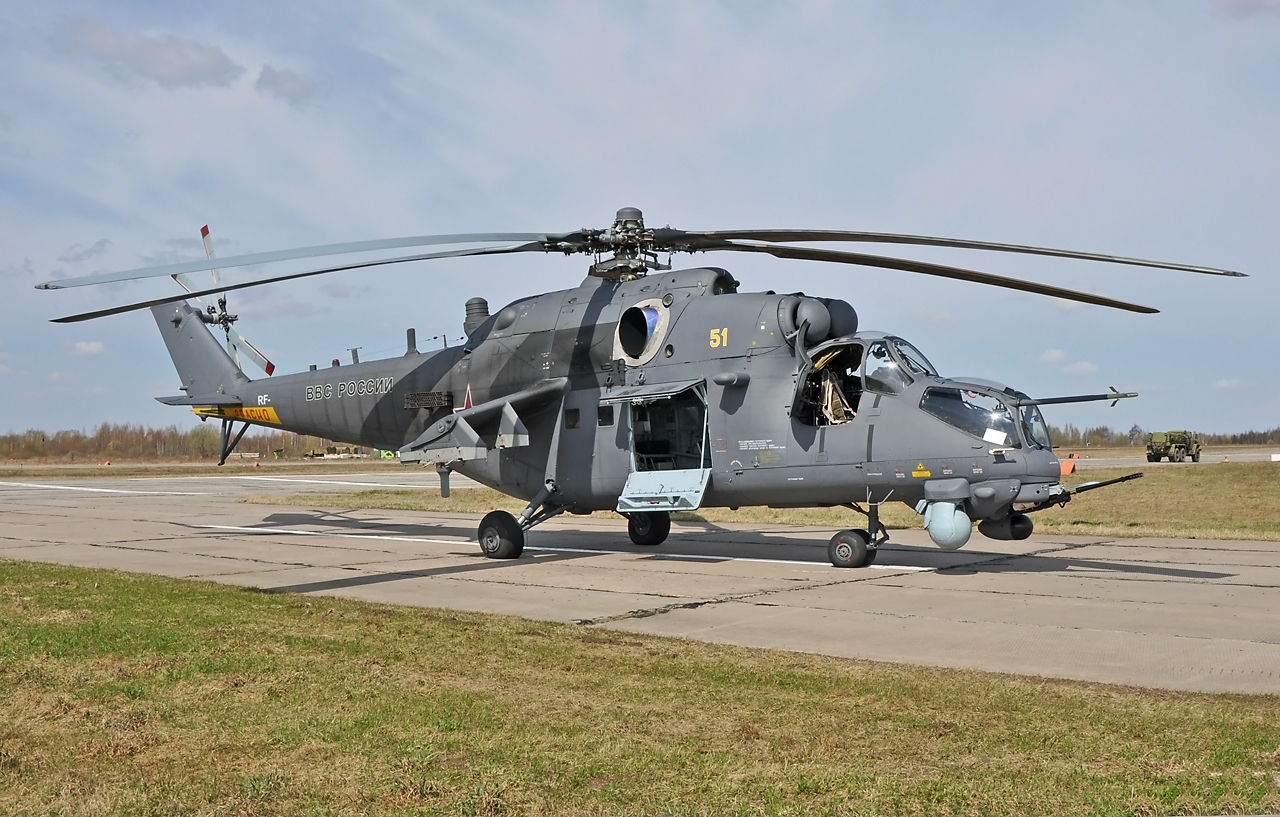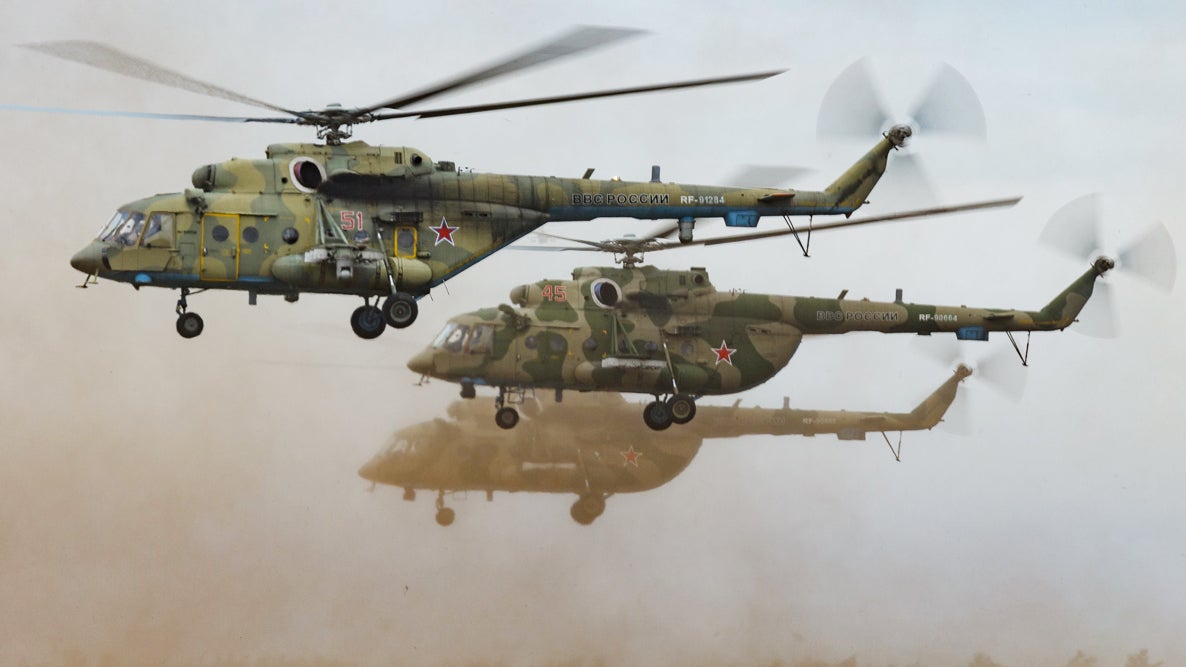More Russian military helicopters appear to be arriving in Russian-occupied Crimea, on Ukraine’s southern border, as concerns that Moscow could be preparing some kind of new invasion of Ukrainian territory continue undiminished. The build-up of Russian troops and materiel into different border areas has been well documented but, until now, additional deployments of military aircraft, specifically, from elsewhere in the country have not been closely observed. If accurate, this is a significant development, coming on top of all the other assets that Russia has been moving into the region in recent months.
A series of videos and photos posted to social media accounts within the last 24 hours purportedly show formations of Russian Aerospace Forces, or VKS, helicopters moving into Crimea’s Kerch region, in the far east of that peninsula, on the coast of the Sea of Azov. Examples of the Ka-52 Hokum and Mi-28N Havoc attack helicopters, at least seven Mi-24/35 Hind armed assault helicopters, Mi-8AMTSh Hip combat transport helicopters, and Mi-26 Halo heavy transport helicopters are seen in the videos and imagery.
While the location and the precise date of the imagery cannot be confirmed at this point, the movement of these kinds of assets to locations closer to Ukraine’s borders had been widely expected. There had also been prior reports of Russian aviation assets being deployed to undisclosed locations in these regions, although this hadn’t been supported so far with imagery. In particular, U.S. intelligence apparently identified movements of additional attack aircraft and Army Aviation helicopters into the region. Although the locations of these movements have not been revealed, unnamed U.S. officials recently confirmed the development to the New York Times.
According to Rob Lee, a fellow in the Foreign Policy Research Institute’s Eurasia program, the helicopters seen here are potentially drawn from the 55th Independent Helicopter Regiment (55 OVP) of the VKS, home-based at Korenovsk, in Krasnodar Krai, within the North Caucasus region of Russia’s southwest.
The 55 OVP is a mixed regiment that includes a squadron of Mi-8AMTSh helicopters, a squadron of Mi-28N and Mi-35M helicopters, plus a squadron of Ka-52s. The regiment already has a connection to Crimea. When Moscow annexed the region from Ukraine in 2014, the Ka-52 squadron relocated to Dzhankoy on the peninsula as part of the 39th Helicopter Regiment (39 VP) that also has a squadron of Mi-28N and Mi-35M helicopters, and one flying the Mi-8AMTSh. Unlike the regiment at Korenovsk, however, the 39 VP does not operate the big Mi-26.
Helicopters were an integral part of the 2014 campaign in Crimea, with particular operations including a reported landing by 11 rotorcraft in the Kerch region, these arriving on Ukrainian territory under the pretense of taking part in Black Sea fleet drills. The wider 2014 operation serves not only as an example of how these kinds of airmobile capabilities could be employed, generally, but also speaks to how the Russians have utilized helicopters in this region in the past.
A video purportedly showing Russian helicopters taking part in the 2014 invasion of Crimea:

The 55 OVP subsequently received another squadron of Ka-52s to replace those that moved to Crimea permanently. During a previous build-up of Russian forces around Ukraine’s borders in early 2021, the 55 OVP again moved some of its aircraft to Crimea.
As we examined in our detailed report on the airpower balance between Russia and Ukraine, any kind of new major military intervention by Moscow against its neighbor would likely make extensive use of VKS assets.
Of those aircraft identified as recently arrived in Crimea, the Ka-52 is a side-by-side two-seat combat helicopter with a dual reconnaissance and attack role, while the Mi-28N has a more conventional tandem two-seat configuration and is primarily an anti-tank and attack helicopter. Both these types also have anti-helicopter capabilities, using infrared-guided Igla-V missiles, as seen in the photo below.
The Mi-35M is the latest version of the iconic Hind assault helicopter for the VKS and incorporated various features taken from the advanced Mi-28N.

The Mi-8AMTSh, meanwhile, is a fully modernized version of the famous Hip transport helicopter, optimized for combat transport, with a capacity for up to 34 troops that can exit via a single-piece rear ramp. The helicopter can also carry armament on its stub-wing hardpoints.

Finally, the Mi-26 is the world’s heaviest operational helicopter and provides the VKS with a unique vertical-lift capability, with the ability to carry large loads such as 82 troops, 68 fully equipped paratroopers, or various military vehicles that can be driven straight out of the hold via a rear loading ramp.

In the various different scenarios for a new Russian intervention on Ukrainian territory, some kind of attack via the annexed Crimea in the south is considered a very likely component, perhaps in combination with an amphibious assault on the city of Odessa, and likely also accompanied by an attack from the Russian border and at least one other direction. The recent arrival of a flotilla of Russian Navy amphibious warfare ships in the Mediterranean has raised further concerns about amphibious landings along Ukraine’s southern coastlines, especially in the Sea of Azov. Such operations would also involve helicopters, both transporting troops and materiel and for providing close support.
Whatever kind of operation might be in mind, if Russia were to launch offensive operations from the south, as part of what would likely be a wider strategy involving other vectors, it would be expected that additional helicopter and potentially fixed-wing aircraft assets would be moved to Crimea.
Currently, VKS airpower on the Crimean peninsula, in addition to the aforementioned 39 VP, comprises a composite regiment with Su-24M strike aircraft and Su-25SM ground-attack aircraft, plus a fighter regiment with Su-27SM, Su-27SM3, and multirole Su-30M2 fighters. In addition, further strike capabilities are provided by a Russian Navy regiment equipped with Su-30SMs, Su-24Ms, and reconnaissance-equipped Su-24MRs.
Separately, Russia has been deploying combat aircraft to Belarus, with which Ukraine shares a border in the north. These aircraft are officially in Belarus to take part in joint military maneuvers with Russia, although there have been consistent worries that Moscow may launch an attack on Ukraine via Belarus, in which pre-deployed aircraft would likely also be employed.
Despite the continued Russian military build-up close to its borders, Ukraine has urged for calm while continuing to align itself with allies in Europe.
At the same time, Ukrainian President Volodymyr Zelenskiy today signed a decree that he says will increase the strength of the country’s armed forces by 100,000 troops over the next three years, adding to the roughly 250,000 personnel serving today. While the country has been receiving military materiel from various NATO countries, its overall strength and capabilities are vastly outclassed by those of Russia, especially in the airpower realm. While U.S. State Department has approved the transfer to Ukraine of five Russian-made Mi-17 Hip helicopters that had belonged to the now-defunct Afghan Air Force, this represents little more than a token force when seen against the available Russian inventory in the region.
Importantly, however, recent talks between Ukraine and Poland have included deliveries of man-portable air defense systems, or MANPADS, that would pose a threat to low-flying Russian aircraft, including helicopters, in a conflict scenario. Weapons of this type already played a key role in the fighting in Ukraine’s eastern Donbas region in 2014, exacting a heavy toll on Ukrainian military aircraft when used by pro-Russian forces during that campaign. Poland has also said it plans to deliver unspecified drones, artillery ammunition, and mortar bombs.
On the diplomatic side, the West last week formally rejected the Kremlin’s demands to prevent Ukraine from ever joining NATO and to withdraw certain NATO forces from Eastern Europe.
For the time being, the situation remains delicately poised, with Russia continuing to field more than 100,000 troops, plus heavy equipment, including short-range ballistic missiles, near Ukraine’s borders. The apparent arrival of helicopter reinforcements in Crimea suggests that Russia plans to continue its military build-up. While additional tactical airpower arriving in the region could be an important signal that a large-scale offensive is imminent, it remains entirely possible that any additional helicopters now in Crimea are simply taking part in exercises and will return to their home base. Regardless, deploying helicopters to the region from elsewhere in Russia represents a significant development in the military buildup that has not been previously seen.
Whatever Russia’s ultimate plan is, the appearance of highly capable helicopters in occupied Crimea is another indicator of the strategic depth and varied capabilities that Moscow would be able to wield in any number of military scenarios.
Contact the author: thomas@thedrive.com
